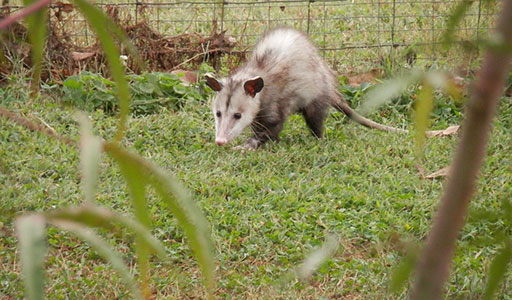Opossums

Opossum Information
Opossums are small grey mammals with a white face and long snout. Opossums habitat wooded areas and will seek natural shelter in abandoned trees and logs. When opossums are threatened, they will “play possum,” mimicking the appearance of a dead animal by laying on the ground with an open mouth. In this position, opossums are protected from any potential predators. Opossums are nocturnal animals, meaning that they are most active during the night. And, although they do not hibernate, opossums are less active during the winter months.

What does a Opossum look like?
Opossums are generally about the size of house cats. They measure between 2 and 3 feet long and weigh no more than 15 pounds. Adept climbers, opossums have oddly shaped hind feet with opposable thumbs. Other distinguishing features include their long, pointed snouts, fierce, dark eyes, and hairless prehensile tails. Males are generally larger than females.

What does a Opossum eat?
Opportunistic foragers, opossums are omnivorous and enjoy a diverse diet. They eat anything from trash to carrion. Some of their favorite meals include snakes, frogs, birds, eggs, berries, nuts, fruits, and various other forms of vegetation.

Opossum habitats
Native to North America, opossums are highly adaptable and now live in a range of climates. In the wild, they prefer to live under natural cover and are frequently seen in the tree tops. Unless a mother opossum is tending to her offspring, the animals prefer to live alone.
Frequently Asked Questions
Opossums are attracted to yards in search of green plants, bird eggs, and rodents, consuming fruit and nuts when available. Similar in size to cat droppings, opossum droppings contain visible bits of their diverse diet.
In the yard, their odd-looking dung is often found atop patios and along walkways. However, enjoy the lawn with caution, as opossum waste is sometimes hidden within gardens or other brushy areas.
While opossums are known for rolling over and playing dead to avoid predation, they more frequently act aggressively and make a variety of noises such as hissing, growling, and screeching. During mating season, the pests also use a series of clicking noises and other auditory signals reminiscent of birds to communicate with their young. Additionally, they forage for food at night, and residents of infested properties may hear opossum sounds like rustling coming from outside.


